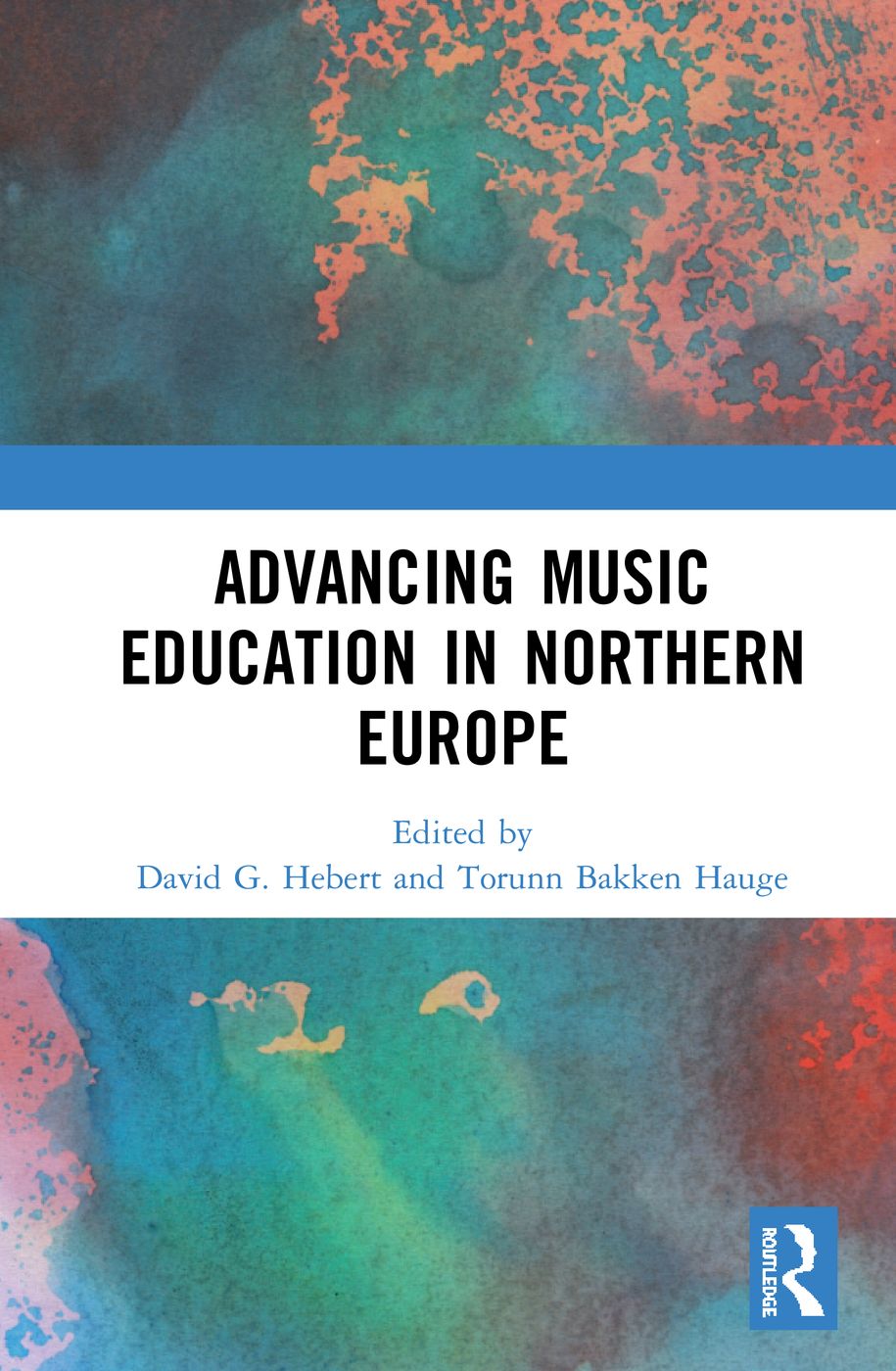Advancing Music Education in Northern Europe: Twenty Years of the Nordic Network for Music Education edited by David Hebert and Torunn Bakken Hauge was published in 2019 by Routledge.
Review by Adam Świtała PhD student at the School of Education, University of Iceland, composer, musician and music teacher
The book offers a comprehensive view on music education in the Nordic and Baltic countries by presenting individual perspectives of renowned scholars from Sweden, Norway, Iceland, Denmark, Finland, Estonia, Latvia, and Lithuania, who describe their experiences with the Nordic Network of Music Education during the twenty years of its existence. The book’s fourteen chapters offer deep insights into the status quo and historical context of music education practice and research in the Nordic and Baltic regions followed by a critical analysis of the activities of the NNME. For readers unfamiliar with the NNME, it is a government sponsored network that includes each of the institutions in Northern Europe that offer a Master degree in music education, and its main activities include sponsoring the travel of teachers and students between member institutions as well as an annual intensive Master course hosted by a different institutional member each year. The three major themes addressed by the network’s projects during its twenty years of existence—democracy, universality and sustainability in music education—become a framework for the individual scholarly perspectives, resulting in a mosaic of deeply informative insights written with remarkable honesty. In the Introduction chapter, the editors present the general concept of the book and its relevance to the contemporary state of art in the field of music education research. Chapters 2-11 focus on challenges of music education in the Nordic and Baltic countries and provide individual authors’ personal insights on their involvement in the NNME. Chapters 12 and 13 present two innovative, yet very different approaches to music education introduced in the recent years. In the Conclusion chapter, the editors summarise the main topics highlighted by the individual authors and discuss future perspectives for the network’s vision and activities, while providing a thoughtful analysis of the broader international context of music education, and acknowledging additional perspectives not included in the book.
Chapter 1: Introduction
In chapter one the editors David Hebert and Torunn Bakken Hauge introduce the reader to the concept and activities of the Nordic Network of Music Education, emphasizing its significant role in supporting professional development of music teachers in the Nordic and Baltic countries, even in recent times when international collaborations are facing severe challenges related i.e. to the resurgence in protectionism and nationalism. Bakken Hauge and Hebert also highlight the importance of the Nordic and Baltic perspectives for the international educational context and provide a brief introduction of the socio-historical context of the Nordic and Baltic (NB8) region of Northern Europe. The book, although mainly targeting readers involved in the field of music education, is also written with a broader audience in mind and can serve as a valuable resource providing an overview of the educational landscape of the Nordic and Baltic countries.
Chapters 2 and 3: The complex educational landscape of Sweden
In chapter two, Master’s seminars in music education across 18 years. Inclusion, equality and democracy as lived experience, Cecilia Ferm Almqvist describes the NNME’s evolution across almost two decades through the lens of her own involvement with the network. Ferm Almqvist describes her journey with the NNME, from master student-participant, through PhD, to becoming member of the network’s board. She explains the importance of the experience gained with the network for her work as organizer in other projects and introduces the NNME as a community of practice funded on the idea of holistic dialogue-based education. Almqvist ends her chapter with open questions inspired by the debates held during the NNME courses, addressing some of the highly relevant topics for contemporary music educators, researchers and event organisers.
Chapter three, Reflections on research collaborations. A call for Nordic research on music education, sustainability, and democracy, is in itself an example of a collaboration between supervisory professor and PhD student in the spirit of the NNME. Eva Sæther and Adriana Di Lorenzo Tillborg start by introducing a detailed map of the Swedish music education landscape. Next, they explore the links between music education and social sustainability, with a particular focus on the Swedish implementation of El Sistema orchestra education. El Sistema becomes as framework for an in-depth investigation of opportunities and issues related to multiculturalism, inclusion, curriculum building, and music education as a tool for collective empowerment. The authors refer to reflexive awareness as one of the key ingredients of socially responsible educational programs and emphasise the important role of networks such as the NNME in stimulating critical and reflective approaches.
Chapters 4 and 5: Thought-provoking Norwegian perspectives
After a brief description of her own involvement with the NNME, Tiri Bergesen Schei in the chapter Musical performance and tacit self-censorship focuses on the mutual influences of the performer’s identity building processes and the act of performance. The chapter suggests that research in the above field is almost inevitably biased as the very fact of choosing categories to describe qualities of a musical performance shapes the scope of potential research findings. Bergesen Schei proposes a new thought-provoking perspective on the performer’s autonomy by confronting the construct with what she calls tacit self-censorship, an essential act in communication between the performer and different types of audiences. Through re-evaluating the meaning of some of the well-established terms, i.e. “musical performance”, she emphasises the importance of investing music as a social construction which always functions within a complex polyphony of cultural contexts.
In chapter five, Music, universality and globalization. Some challenges for music education in the decades to come, Geir Johansen challenges the “romantic notion” of music as a universally good activity. He analyses some of the popular statements about music as a “universal language” and proposes a new critical perspective on music education, acknowledging a broader variety of notions. The core of the chapter consists of a comparison of popular statements about music’s universal positive power and headlines from major newspapers and scholarly papers presenting a rather grim series of events which all had one thing in common: a central role of musicians or music teachers. Geir suggests that the European eagerness to present music as a universally beneficial activity is deeply rooted in Western classical music tradition and might blur deeper insights on the true outcomes of music. He proposes a descriptive-analytic approach as an alternative for the highly biased normative approach as well as investigating the concept of the universality of music from different scholarly perspectives.
Chapter 6: An Icelandic point of view
In chapter six, An Icelandic perspective on the Nordic music education community, Helga Rut Gudmundsdottir shares her insights on the evolution of the NNME network from the perspective of an Iceland-based scholar involved in many international research projects. Gudmundsdottir’s personal experience of being, to some extent, both an in- and outsider resembles the specific position of Iceland within the Nordic educational landscape in many ways and presents an opportunity for a well-informed critical perspective. The chapter focuses on some of the major challenges the network had to face, from choosing the language primarily used for communication within the network, to fundamental concerns regarding different methodological approaches not being equally represented among the course leaders followed by possible strategies for improvement. Furthermore, the chapter contains insightful opinions from Icelandic students who had participated in the NNME intensive courses. Explaining the network’s potential as a platform to observe, learn about and negotiate national stereotypical behaviours, Gudmundsdottir provides a thoughtful analysis of the similarities and differences between educational systems in the individual countries involved with the network and highlights issues necessary to be addressed in the networks future actions and policy.
Chapter 7: The collective aspect of music making. Insights from Denmark
Lars Brinck uses the experience gained from participating in the actions of the NNME as a framework for reflexive analysis of the Danish music education system. Musician and teacher. Higher popular music education in a Danish perspective invasigates different angles of looking at popular music education in the Nordic countries and the importance of investigating the collective aspect of PME. He points out that collective activities are an essential part of PME and are often being misrepresented within the individualistic approach predominant in Western research tradition and even amplified by some of the new research tools deriving from fields like neuroscience. According to Brinck, an important role of networks such as the NNME in the above context is bridging research and educational practice. Furthermore, the chapter presents the NNME as an important statement in itself: a democratic collaboration model with a potential to overcome borders of different kinds.
Chapter 8: Finland. Co-operation instead of competition
Chapter eight, Advancing music education via Nordic cooperation. Equity and equality as central concepts in Finland by Marja Heimonen and David G. Hebert, starts with a brief introduction to the Finnish music education system as well as Finnish research in this field over the past two decades. The authors describe Finland as a particular example for how excellence in music education can be achieved through focus on co-operation and freedom of choice rather than competition. Next, the chapter offers a critical analysis of the meanings behind equity and equality in music education, introducing the concept of “positive discrimination” as applied in Finnish educational policy. Heimonen and Hebert investigate the problematic aspects of equality i.e. with regard to auditions, talent assessment and new technologies in the music classroom, as well as gender-related stereotypes. Furthermore, the chapter investigates similarities and differences between Finland and other Nordic countries in terms of the applied educational policies and how much can be learned through international collaborations.
Chapter 9. The Estonian way
In chapter nine, Bridging the past, present and future in Estonian music education, Anu Sepp, Urve Läänemets and Kristi Kiilu introduce the historical context and main principles of the music education system in Estonia, a country geopolitically located between the Nordic and the Baltic region of Europe. The authors investigate the historical foundations of Estonian music education, from the XIX century through the times of Soviet oppression, up to the present day. By doing so, they shed some new light on the phenomenon of the enormous popularity of collective singing in the Baltic republics and investigate the significance of singing for the preservation of Estonian national identity. Sepp, Läänemets and Kiilu introduce the reader to original Estonian pedagogical approaches in music education concluding the chapter with a discussion on some of the major challenges in the field of curriculum making and future prospects of the Estonian educational system.
Chapter 10. Latvia: the competence-oriented new paradigm
Māra Marnauza and Sanita Madalāne present the Baltic-Nordic cooperation and research exchange as an important catalyst for new ideas and reforms in Latvian music education. The chapter A paradigm shift in Latvian music teacher education. A selection of research experience in the period 2008-2017 provides an overview of the Latvian contribution in the field of music education since the Baltic countries joined the NNME in 2008. Building upon principal values shared by the NNME community – democracy, universality and sustainability, the Latvian educational system follows an apparently different paradigm than the Nordic countries, focusing on individual competencies rather than collectivity. However, a closer analysis of the applied approaches reveals underlying similarities, making the chapter yet another strong voice advocating for the importance of reflection and critical thinking, emphasizing the value of international networks like the NNME as platforms for learning from a variety of different perspectives.
Chapter 11. The challenges of music education in Lithuania
Jolanta Lasauskienè in chapter 11, Music teacher education challenges. National and international perspectives in Lithuania, describes the main principles of music teacher education in Lithuania, emphasizing the significant contribution of the Nordic countries to the political, social, cultural and economic processes in the country after the restoration of its independence in 1990. Despite severe differences between the educational systems in the post-soviet republics and the approach endorsed in Northern Europe, professional friendships made within the NNME have resulted in fruitful continuous professional collaborations. For Lasauskienè, the participation of the Lithuanian University of Educational Sciences in the actions of the NNME becomes a critical mirror for a reflexive analysis of the dynamically changing new reality in the country. Furthermore, the chapter offers a thoughtful analysis of difficulties faced during the attempts to apply well-established foreign educational models in the Lithuanian cultural context and the impact on nationwide educational policies on teacher education and classroom reality, followed by suggested strategies for finding relevant solutions.
Chapters 12 and 13. Different takes on innovative classroom environments
Chapters 12 and 13 both present examples of innovative pedagogical concepts in the field of music education. Lolita Navickiene, Asta Rauduvaite, Giedrė Gabnyte and David G. Hebert provide a detailed description of the Emotional imitation method in the context of Lithuanian music education, its philosophical foundations and methodical framework. Their chapter includes example lesson scenarios designed with the application of the EIM in Lithuanian schools in mind. The following chapter, Integrated learning of music and science. Reception of Björk’s Biophilia Project in the Nordic countries by Bård Vågsholm Husby and David G. Hebert, offers a comprehensive analysis of the Biophilia project, initiated by Icelandic celebrity artist Björk Guðmundsdóttir, and the lessons learned from its application in classroom practice in Icelandic and Norwegian schools. Based on the analysis of Biophilia and the critical response the project had received, the authors discuss the potential and challenges of collaborations between artists, researchers and policy makers in the field of music education and draw conclusions regarding the introduction of new technologies in the music classroom.
Chapter 14. Global context and missing perspectives
In the final chapter of the book, the editors discuss the fundamental importance of international collaborations in the current political context and take a detailed look at socioeconomic differences between the Nordic and Baltic regions as well as individual countries within the NB8. Hebert and Bakken Hauge discuss the themes of democracy, universality, and sustainability with reference to the multiyear projects of the NNME and investigate possible issues to be addressed in the future related to language barrier and cultural differences. Notably, the authors dedicate a thoughtful paragraph to the recognition of important voices that received minimal attention in the book, especially those of indigenous peoples, minorities, and recent immigrants. They highlight connections and mutual influences of philosophical thought in education across continents and centuries, endorsing recognition of Europe’s cultural diversity as potential.
Conclusion
The book clearly is a unique proposition for scholars and policy makers in the field of music education. Written by renown researchers, based on twenty years of practical experience of the Nordic Network of Music Education, it provides unique and well-informed insights on music education in the Nordic and Baltic countries and can be considered a one-of-a-kind handbook for designing international collaborations supporting teacher training and research exchange. It also presents great value as an unprecedented attempt to deliver a comprehensive, informative overview of music education in the countries of the NB8, covering both a summary of the historical contexts and a critical analysis of the present status quo. While some previous books have provided information on selected Nordic countries, this appears to be the first book in English to offer insights into recent developments in music education across each of the Baltic and Nordic countries as well as comparative discussion. The editors did a great job in balancing out the content written more with a professionally engaged reader in mind and the insights relevant for a broader audience, reaching out beyond academia. The book is also a valuable resource for students on all university levels. The personal narratives chosen by some of the authors offer room for highly relevant insights of less formal nature which are rarely to be found in scholarly writing and become one of the books definite advantages. I enjoyed reading the book and was impressed by the diversity of the included content and how respectfully it was set withing a broader educational, philosophical and socio-political context. I assume that what is mentioned here as the book’s strengths, might also be challenging for some readers seeking a more cohesive narrative. The individual chapters differ significantly: some focus more on the NNME as a collaborative project, while some are of more philosophical nature, and some derive from research papers and do not address the book’s broader themes in a direct way. Having said that, it seems a valid question to ask whether the proposed pluralistic, yet well-structured formula is not the most relevant approach to discuss democracy, universality and equality. If Advancing Music Education in Northern Europe… was a concert, it would certainly deserve the label of a cross-genre event. In that sense it quite literally stands for the values endorsed by the NNME, by thoughtfully facilitating all the diverse voices into a meaningful polyphony.
About the reviewer
Adam Świtała is a PhD student at the School of Education, University of Iceland, composer, musician and music teacher. Born in Warsaw, Poland, currently based in Reykjavik, he was board member of the Polish Music Council in the years 2017-2020 and president of the Polish Association for Music Education 2017–2018. He worked as lecturer and teacher trainer in several European countries and directed a nationwide research investigating the music classroom environment in compulsory schools in Poland. 2019-2020 Adam served as member of the editorial board for the ISME/Routledge book series “Specialist Themes in Music Education”.
Available to buy
Physical book: available from all good book retailers including Book Depository - paper book, freight free.
Ebook: go to Books2Read which will provide you with a range of suitable links for an e-version of this book
Hebert, D. and Hauge, T. B. (eds). (2019). Advancing Music Education in Northern Europe: Twenty Years of the Nordic Network for Music Education. London: Routledge.













